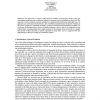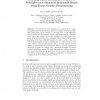138 search results - page 13 / 28 » Evolved Neurodynamics for Robot Control |
ICRA
2009
IEEE
14 years 5 months ago
2009
IEEE
— Unlike statically stable wheeled mobile robots, dynamically stable mobile robots can have higher centers of gravity, smaller bases of support and can be tall and thin resemblin...
ICES
2010
Springer
13 years 8 months ago
2010
Springer
Abstract. In an application where autonomous robots can amalgamate spontaneously into arbitrary organisms, the individual robots cannot know a priori at which location in an organi...
GECCO
2004
Springer
14 years 4 months ago
2004
Springer
This study describes how complex goal-directed behavior can evolve in a hierarchically organized recurrent neural network controlling a simulated Khepera robot. Different types of ...
CORR
2004
Springer
13 years 10 months ago
2004
Springer
An approach to robotics called layered evolution and merging features from the subsumption architecture into evolutionary robotics is presented, and its advantages are discussed. T...
GECCO
2003
Springer
14 years 4 months ago
2003
Springer
We describe the first instance of an approach for control programming of humanoid robots, based on evolution as the main adaptation mechanism. In an attempt to overcome some of th...


